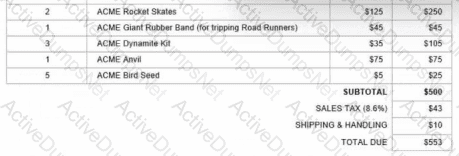UiPath UiPath-ABAv1 UiPath Certified Professional Automation Business Analyst Professional v1.0 Exam Practice Test
UiPath Certified Professional Automation Business Analyst Professional v1.0 Questions and Answers
How many samples are recommended to train a custom ML model that has one custom extra field?
During the User Acceptance Testing phase of Automation Implementation, if there are deviations from the expected outcomes, who is primarily responsible for logging those and working towards resolving those issues?
What is the final step the business analyst must take to complete the Process Design Document?
What stages are involved in the Automation Change Control Process in an automation project?
What are the environments that the UiPath Platform provides entitlements for deploying and licensing the product?
What does the Business Benefit of Flexibility refer to?
Which of the following needs to be filled in the Process Assessment Tool?
What is the status of an action when it first shows up on the Actions page in UiPath's Action Center?
How do Storage Buckets function in UiPath Orchestrator?
When executing test cases during the User Acceptance Testing phase of Automation Implementation and an unexpected scenario arises that was not covered in the initial plan, what should the Business Analyst do?
As a business analyst, how would you organize the testing effort in UiPath Test Manager?
Which of the following statements is true considering Attended vs Unattended Automation?
What is the purpose of prioritization criteria in the business analysis phase?
Which is the most effective way for a Business Analyst to document business exception handling for an automation process?
What type of data is Communications Mining optimized for?
Sequence the steps correctly for the creation of a new process app in UiPath Process Mining.
Instruction: Drag the Description found on the left and drop on the correct Step found on the right.

What is a process in the context of an automation implementation using UiPath?
When an application stops responding, what should it be treated as?
What are 2 key features of UiPath Automation Hub?
According to UiPath's best practices, when should the test scenarios and test cases be created?
What does Test data represent?
What tool is recommended for data modeling and analytics?
In the context of the Robotic Enterprise Framework, what do we call a transaction?
When prioritizing the processes to be automated based on the Automation Quadrant, what is a process with LOW complexity & HIGH benefit considered?
Which of the following is considered a Thin Client?
Which of the below options best applies to the role of the Business Analyst?
Which of the following are structured documents that can be processed with Document Understanding?
Which of the following statements best describes "human in the loop" automation?
From a Document Understanding perspective what kind of document is the one below?


Make all checks payable to ACME Corporation
If you have any questions concerning this invoice, contact Road Runner
THANK YOU FOR YOUR BUSINESS!
What is UiPath Process Mining?
What feature can an end-user use on Process Mining Cloud to see potential savings for manual activities in their process?
Based on the image, when should you choose the Build Trace option?

What is the role of UiPath Automation Hub?
By what step at most should the analysis of input and its future standardization be decided upon?
What is the difference between attended robots and unattended robots?
How can UiPath Communications Mining help organizations improve their customer service?
Which subfield of Artificial Intelligence does UiPath Communications Mining leverage?
Which type of automation is most commonly used in Customer Service or Customer Support processes?
What should the RPA Business Analyst do during the Build RPA phase?
What kind of document is a contract?
When does a queue item get the 'Deleted' status?
Can an attended user run multiple processes in parallel in Assistant?
What event can affect selector reliability in automations?
Which of the following are one of the three features offered by UiPath Process Mining within the Automation Potential dashboard?
What is the purpose of using the Test Cases template to create test case scenarios?
In UiPath Studio ReFramework, what can be the output from the Process Transaction state?
Which one of the Communications Mining chart pages shows charts of label volumes split by messages metadata category?
What is a key feature of Orchestrator?
What tool is recommended to track the testing effort?
What is the primary goal of task analysis in the context of evaluating automation potential?
In which phase of the automation lifecycle does Task Mining belong?

